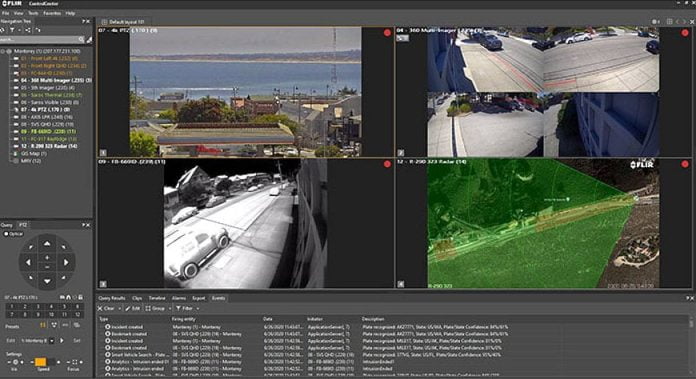FLIR United Video Management System (UVMS), which includes Latitude software, and Horizon, and Meridian network video recorders, now features 4 new integrations.
The Teledyne FLIR Applications & Integration Center (AIC) group is integrating third-party products with the FLIR UVMS, allowing users to manage their systems from a single operating platform. Installed as plugins, integrations from AIC complement the UVMS core features, enhance the complete solution, and create synergies with the different Teledyne FLIR products.
The new integrations have recently been released for UVMS include:
* Video redaction for enhanced privacy
* FLUX integration for traffic monitoring in Latitude
* Radar integration for enhanced perimeter protection
* Condition monitoring monitoring to go beyond security.
Video Redaction
The video redaction plugin allows UVMS to comply with increasing privacy regulations for security applications. It extends the Latitude VMS with the ability to perform video redaction – obfuscation of personal information in videos for privacy protection – on exported video files, by launching a redaction application from within the UVMS Control Center.
The redaction application may either be launched manually by pressing a Manual Redaction button in Control Center, or automatically upon completion of exporting video to files. The video redaction is very flexible: it allows users to exclude a suspect or innocent bystander in the image, or to redact any other item, such as license plates or signs that should not be seen. This integration is available for Latitude, Horizon, and Meridian.
There are options for automated face redaction and body redaction, and you can merge redaction paths. This latter option comes in handy if a person walks back and forth, in and out of the view of the camera a few times. Without merging, this kind of activity would appear to be seen as multiple faces that need to be redacted. With the merge redaction path option, you only need one redaction for one person’s itinerary.
FLUX Traffic Monitoring
The UVMS-FLUX integration brings traffic events from the FLUX traffic management system into Latitude. In the control room, users can monitor traffic cameras and be alerted upon events. For example, if smoke is detected in a tunnel, an alarm will be generated, and the relevant cameras will automatically pop up on the Latitude Control Center.
The traffic event will be recorded, and the video will be bookmarked for later forensics needs. To later search for the recorded video from an event, the operator can go to UVMS control center, select a bookmark, choose the camera and determine the relevant time to search within. The operator can see the timeline, the recording before and after the event, and the bookmark itself which contains all the information about the event.
Upon the detection of an event, UVMS can be configured to automatically perform a wide range of operations, including start recording, stop recording, moving a PTZ camera to the required location, trigger an alarm, and much more.
Radar Integration
Radars are a growing trend in perimeter protection. With just a few radar systems, you can cover large areas in any weather condition. The UVMS radar integration can support multiple radars and multiple PTZ cameras, displaying the moving radar targets on a GIS map and allocating PTZ cameras to track them according to selected tracking modes.
The integration today supports the FLIR Ranger radars (R1, R2, and R3), as well as the coming R-290 radar, but it can be easily extended to additional FLIR and non-FLIR radars. It is also possible to receive targets from other sources beyond radars, like drone detecting systems etc.
In UVMS, users have a wide range of configuration options:
* Camera or walking range: This is the range in meters in which PTZ cameras will be engaged by radar targets. If a target is detected within the range of a certain PTZ camera, then that camera will auto-track it. This is a way to avoid having all cameras tracking the same targets at the same time.
* PTZ tracking modes: This allows you to prioritize tracking when multiple targets are detected. you can choose between tracking the latest acquired target within the configured camera range, tracking the latest target within an alarm zone, tracking the target closest to the camera, and cycling between all targets staying on each target for a number of seconds. Users can always take manual control and override the mode if necessary.
* VMS behaviour upon incoming events: In this radar integration, four event types are defined: target detected, target in alarm zone, target lost, and tripwire crossed. When any of these events occur, the VMS might dispatch an event, trigger an alarm, do both, or completely ignore the event.
* Elevation data: For long distance radars and for cases where the ground is not particularly flat, you can use ground elevation data to guarantee precision PTZ tracking.
Condition Monitoring
The condition monitoring plugin allows VMS operators to monitor temperature data from FLIR thermal imagers in a visual way, and to be alerted upon temperature readings above and/or below preconfigured thresholds. This integration for Latitude currently supports FLIR’s A400/A700 camera models, as well as the A500 and A50/A70. A version supporting the A310 and Ax8 will come later this year.
Users can create their own views (maps) with gauges, indicators and line charts, dynamically showing the current state. The VMS administrator can also configure any desired VMS operation (trigger an alarm, generate a pop-up video) to occur upon the temperature events. Latitude also allows you to run reports presenting historical information based on alarms, and temperature fluctuations within the system showing abnormal or normal conditions.
#sen.news











